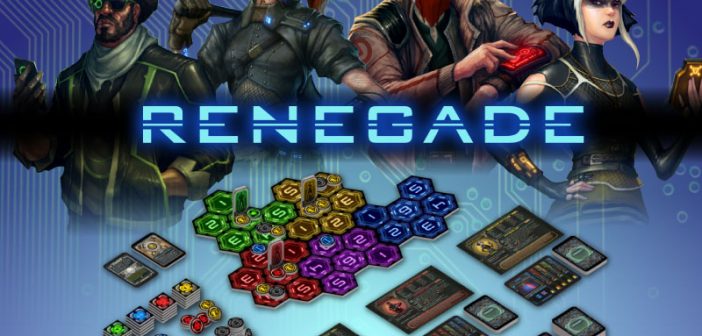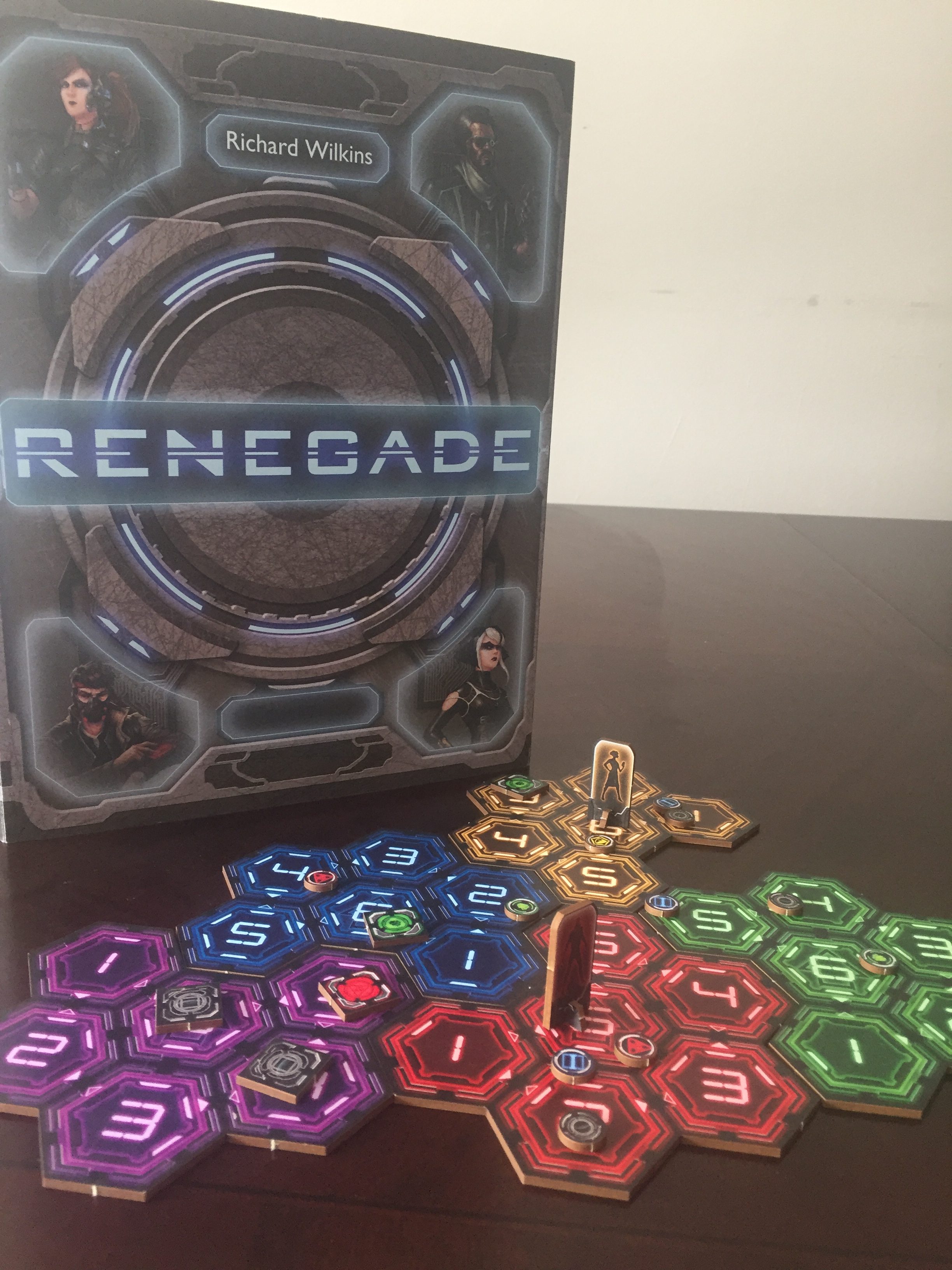If you are someone who frequently looks on YouTube for game tutorials, you probably know Ricky Royal (née Richard Wilkins) and his Box of Delights channel. I’d say he’s up there with Rodney Smith’s Watch it Played channel in terms of go-to places to learn games, and deservedly so. When I brought a copy of his game Renegade to my local meetup, no less than four people exclaimed “Ricky Royal? Cool, he taught me Mage Knight!”
Renegade represents Ricky’s maiden voyage into game design. As such, he’s given us something straight out of his personal greatest hits – a coop/ solo game with abstracted positional movement, powered by deckbuilding.
The game is set to arrive on Kickstarter on July 18th. I hope this review will help you decide whether it’s worth backing.
*****Note: The components pictured here are NOT final, only prototype. The game will get a proper printing with nicer components after the Kickstarter.
How to play Renegade
Before we get to mechanisms, let’s talk about the theme of Renegade. In fact, according to this designer diary, that’s exactly where the design process started here: “That’s how I like to approach it. I know what I want my game to be about and then the mechanisms that drive home the theme come along.” In this case, a ragtag band of cyberbunk computer hackers are staging an incursion into a Super Massive Evil Computer Thing (paraphrase). They seek to loosen the Evil Computer’s grip on the minds of the populace at large. You can read more of the backstory of the game in the rulebook.
The theme immediately reminded me of Aldous Huxley’s Brave New World, or Skynet from the Terminator series. I’ve also recently finished a video game with a similar dystopian vision, République. I’m actually surprised that more board games haven’t mined this thematic territory. So, some points for originality right there.
You can see the theme represented right away on the box and on the jigsaw-mat pieces that represent the game board.
Now let’s talk about some gameplay!
If you’ve played Mage Knight, you will recognize the actual way your character interacts with the board. You start with a hand of simple cards, 5 out of a deck of 15, which let you perform some basic actions – move, deploy little helper bots (the colored tokens pictured above), and upgrade those little bots into more powerful, square bots. You can also attack the black/ grey bots that represent the Super Massive Evil Computer Thing’s countermeasures.
The basic cards themselves have no text. A system of colors and symbols drive gameplay.
In good deckbuilding fashion, on your turn, you can swap out these basic cards for better ones in the market. Two mechanical wrinkles differentiate Renegade from classic deckbuilders – a) you swap out one card from your deck for the better card, meaning you always have 15 cards in your deck, and b) you get the better card into your hand for immediate play. The improved cards have more symbols on them that allow for more actions, or they have some kind of extra power that you could use instead.
Dice drive the combat in Renegade. Fortunately, you can stack the odds in your favor by focusing on deploying your red attack bots. You can also forgo attacking entirely and convert the bad little bots to your side! That’s really fun.
You go through your entire deck over the course of a full round, which will give you three turns to accomplish a goal given to you by a separate goal card. Some examples of goals are “deploy every color bot in x amount of starting zones” or “escort a special Trojan Horse bot across x+1 zones.” At the end of every full round, the Super Massive… you get the idea… will counterattack and set up new obstacles that will hinder you as you go for a new goal. Move through three or four of these goals, depending on the scenario laid out by the boss you choose, and you win the game.
There’s a scoring system. However, I found that I ignored it completely, especially for the harder bosses.
What I liked about Renegade
Happily, there’s a lot to like! I compared the card play in this game to Mage Knight, which happens to be my second favorite game of all time as well as my favorite solo game. Right off the bat, Mage Knight hits you with complication that piles up even higher as you keep going. Renegade, on the other hand, starts at an accessible level of complexity, then gradually moves you into a fairly happy middle spot. Once you get into the middle rounds, you will have to pause and do a LOT of strategizing, but it never felt overwhelming.
When I playtested this game at a recent meetup, one of the group was completely new to hobby games. No deckbuilding experience, no history with abstracts… nothing. They were overwhelmed at the start, to be sure. However, with some gentle coaching, she picked it up. By the end, the group set her up for a massive nova turn during the last round, which got her very excited. That will never happen with Mage Knight!
In addition, I never felt like I was truly helpless. My hand from turn to turn always presented me with tons of good options, leaving me to figure out how to execute the best one. I find that more exciting than having to choose the least bad among horrible options. The hardest boss, Mother, was certainly very challenging and had me feeling like I was always behind. However, I found that the challenge was more of an invitation to improve my play, rather than a promise that I will get my butt whooped.
The deckbuilding in this game is very, very smooth. I like that the deck was always 15 cards, which had the double effect of making it easy to remember what I had while also telling me exactly how much time I had left in a round.
Finally, I would definitely recommend this game’s solo mode, as well as the two player mode. The solo game in particular is a really nice puzzle with lots of replayability via the different goal and boss cards.
What I didn’t like about Renegade
This is not a direct criticism, but I am holding my breath at the component quality of the finished product. When I played the prototype, I found myself touching the components a lot. Not only was I fiddling with my pawn when planning movements, I had to flip the helped bot tokens a fair amount because they’re double-sided. Let’s see if Renegade gets a print quality that will really give it the best chance of doing well on the market.
In terms of gameplay, every co-operative game needs to wrestle with the alpha gamer problem. For those who don’t know, it’s where one gamer bosses the other players around and tells them what to do. I don’t think Renegade handles that very well. Players are not supposed to reveal their hands of cards to one another, which theoretically limits player bossiness. However, you’re not supposed to reveal your exact hand in Pandemic, either, and that game practically invented the alpha player problem. There’s just too much social pressure to be clear about what you plan to do on your turn, it’s easier to just tell people what you have in your hand. Many newer cooperative games have developed mechanisms that discourage alpha gaming (timers, hidden info, randomness in key areas, etc.). Renegade chose to move in a different direction.
Also, this game uses a LOT of terminology and jargon. The little helper bots are all called “contaminants,” while the different colors of helper bots are called things like “data nodes”, “uplinks”, and “replicants”. The separate zones of the board also have jargon names like “Faith”, “Salvation”, etc. Talking with the designer, he regards the terminology as a feature, not a bug. I understand his point, once players jump over that conceptual hurdle, the jargon encourages thematic immersion. I still maintain that it’s a bit overdone. I’m a big fan of showing, rather than telling, wherever possible. I’d rather they allowed the look of the game to generate that kind of immersion, rather than put up a wall of words
Speaking of info overload, look at this player mat:
When I laid the game out on the table at the aforementioned meetup and invited people to play, one player took a look at this player aid, said “Nope! No way!”, then immediately walked in the other direction. There is so much on here! WAY too much to be helpful. I can see the Actions List section being useful (though the symbol-language took my group a little getting used to). However, I feel like the Renegade Key Code just adds unnecessary clutter. Another playtester put it better than I could: “player aids should be a bit like Power Point slides; less is more.”
Final Verdict
On the whole, this game is excellent. The mechanisms are tight, striking a good balance between accessibility to new gamers and having something to offer for hardcore strategy gamers. It also helps that I don’t know of another game that replicates Renegade’s ghoulash of mechanisms. I highly recommend the game, especially at a low player count (1-2). My issues with Renegade have more to do with presentation rather than substance.
Hopefully, after reading this review, you have a better sense if Renegade is worth your hard earned (or not earned, or ill-gotten) cash.






